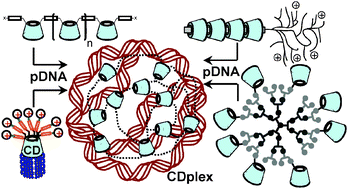Cyclodextrin-based gene delivery systems
Abstract

* Corresponding authors
a
Departamento de Química Orgánica, Facultad de Química, Universidad de Sevilla, Apartado 553, E-41071 Sevilla, Spain
E-mail:
mellet@us.es
Fax: +34 954624960
Tel: +34 954559806
b
Instituto de Investigaciones Químicas, CSIC—Universidad de Sevilla, Américo Vespucio 49, Isla de la Cartuja, E-41092 Sevilla, Spain
E-mail:
juanmab@iiq.csic.es
Fax: +34-954460565
Tel: +34-954489560

 Please wait while we load your content...
Something went wrong. Try again?
Please wait while we load your content...
Something went wrong. Try again?
C. O. Mellet, J. M. G. Fernández and J. M. Benito, Chem. Soc. Rev., 2011, 40, 1586 DOI: 10.1039/C0CS00019A
To request permission to reproduce material from this article, please go to the Copyright Clearance Center request page.
If you are an author contributing to an RSC publication, you do not need to request permission provided correct acknowledgement is given.
If you are the author of this article, you do not need to request permission to reproduce figures and diagrams provided correct acknowledgement is given. If you want to reproduce the whole article in a third-party publication (excluding your thesis/dissertation for which permission is not required) please go to the Copyright Clearance Center request page.
Read more about how to correctly acknowledge RSC content.
 Fetching data from CrossRef.
Fetching data from CrossRef.
This may take some time to load.
Loading related content
